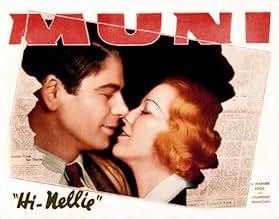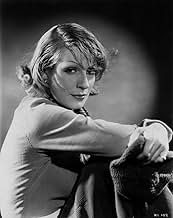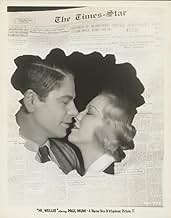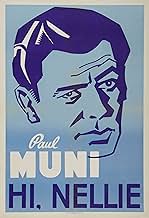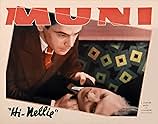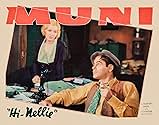The managing editor for a newspaper, in hot water with his boss, is demoted to writing the "Nellie Nelson" heart throb column, where he gets the unexpected opportunity to crack a major story... Read allThe managing editor for a newspaper, in hot water with his boss, is demoted to writing the "Nellie Nelson" heart throb column, where he gets the unexpected opportunity to crack a major story.The managing editor for a newspaper, in hot water with his boss, is demoted to writing the "Nellie Nelson" heart throb column, where he gets the unexpected opportunity to crack a major story.
- Director
- Writers
- Stars
Douglass Dumbrille
- Harvey Dawes
- (as Douglas Dumbrille)
Dorothy Libaire
- Rosa Marinello
- (as Dorothy LeBaire)
- Director
- Writers
- All cast & crew
- Production, box office & more at IMDbPro
Featured reviews
Paul Muni has to get used to hearing "Hi, Nellie!" when he's demoted to the Heartthrobs column in this 1934 film also starring Glenda Farrell and Ned Sparks.
When bank official Canfield disappears at the same time as $500,000 and the bank has to close, all the other papers print that Canfield took the money. Managing editor Brad Bradshaw refuses to tie the two incidences together without proof - thus, the demotion. The current Heartthrobs (Farrell) gets a news beat.
This is one of those fast-talking '30s films, probably in response to the MacArthur-Hecht "The Front Page" from 1931.
It's all pretty routine except that it stars Paul Muni who, as Brad/Nellie, is a wisecracking, sarcastic editor now mercilessly teased by his cronies.
Muni, well known for his dramatic work, shows his expertise at comedy here. Also it's a rare chance to see how handsome he was as he wore so much character makeup and so many costumes throughout his career. He is very good as the determined managing editor turned lonelyhearts columnist. Farrell is her usual sharp-mouthed self; this isn't much of a departure from other roles for her.
Recommended if you want to see Muni in something approaching a comedy.
When bank official Canfield disappears at the same time as $500,000 and the bank has to close, all the other papers print that Canfield took the money. Managing editor Brad Bradshaw refuses to tie the two incidences together without proof - thus, the demotion. The current Heartthrobs (Farrell) gets a news beat.
This is one of those fast-talking '30s films, probably in response to the MacArthur-Hecht "The Front Page" from 1931.
It's all pretty routine except that it stars Paul Muni who, as Brad/Nellie, is a wisecracking, sarcastic editor now mercilessly teased by his cronies.
Muni, well known for his dramatic work, shows his expertise at comedy here. Also it's a rare chance to see how handsome he was as he wore so much character makeup and so many costumes throughout his career. He is very good as the determined managing editor turned lonelyhearts columnist. Farrell is her usual sharp-mouthed self; this isn't much of a departure from other roles for her.
Recommended if you want to see Muni in something approaching a comedy.
Hi, Nellie is one of the most arch, hilarious movie titles I've ever encountered. At first it sounds banal, but as it's tossed around in different scenes by different characters, it gets funnier and funnier. There's a barroom scene that's a howler.
But rather than just a prop for the title's running gag, the story is quite interesting on its own. It involves a newspaper and corruption and a missing banker, and things aren't what they seem. We're taken through some amazing sets. it's impressive to see how many resources were plowed into them by the studio, from tracking shots of the cavernous newsroom, of teeming city streets, of the interior of an elaborate nightclub, all following Paul Muni, who, by the way, is a rough-and-tumble editor relegated to the lovelorn column by his publisher.
And this is a great showcase for Muni. Most of his scenes show him in closeup. Remember, Cagney had Public Enemy and Muni had Scarface, both intensely focused on their personas. I think Muni, because of his stage background, overdraws his character in movie closeups. (He may have won the Oscar for Louis Pasteur because he wore a beard that restrained his over-expressiveness.) But hey, it's Muni, and it's fun to see him do his stuff.
This is a comedy-crime flick, fast-paced, with rapid-fire dialog between great Warner players, so you have to pay attention. There's a scene where a dim young reporter tells Muni that the children's picnic he was assigned to cover didn't occur because the boat taking the kids to the venue ran aground on a sandbar and broke up, so he only had one paragraph to report. This is great stuff!
But rather than just a prop for the title's running gag, the story is quite interesting on its own. It involves a newspaper and corruption and a missing banker, and things aren't what they seem. We're taken through some amazing sets. it's impressive to see how many resources were plowed into them by the studio, from tracking shots of the cavernous newsroom, of teeming city streets, of the interior of an elaborate nightclub, all following Paul Muni, who, by the way, is a rough-and-tumble editor relegated to the lovelorn column by his publisher.
And this is a great showcase for Muni. Most of his scenes show him in closeup. Remember, Cagney had Public Enemy and Muni had Scarface, both intensely focused on their personas. I think Muni, because of his stage background, overdraws his character in movie closeups. (He may have won the Oscar for Louis Pasteur because he wore a beard that restrained his over-expressiveness.) But hey, it's Muni, and it's fun to see him do his stuff.
This is a comedy-crime flick, fast-paced, with rapid-fire dialog between great Warner players, so you have to pay attention. There's a scene where a dim young reporter tells Muni that the children's picnic he was assigned to cover didn't occur because the boat taking the kids to the venue ran aground on a sandbar and broke up, so he only had one paragraph to report. This is great stuff!
Having seen Paul Muni in so many dramas, I wondered if he could pull off comedy as well. I needn't have worried. Since he's teamed with Glenda Farrell, a master of the wisecrack, he gets solid support and the looks they exchange throughout the movie are priceless. One scene that I loved was when Glenda is pretending to be Nellie Nelson so that a woman will confide in her and she's bossing Muni around like he's her office boy.
The plot isn't that original. In fact, there are several versions on the same theme (star reporter demoted), but this one has the star material to give it an extra life. Ned Sparkes also adds to the fun.
The plot isn't that original. In fact, there are several versions on the same theme (star reporter demoted), but this one has the star material to give it an extra life. Ned Sparkes also adds to the fun.
HI, NELLIE! (Warner Brothers, 1934), directed by Mervyn LeRoy, is an interesting newspaper story starring Paul Muni in his third film for the studio. Having achieved great popularity in the title role of I AM A FUGITIVE FROM A CHAIN GANG (Warners, 1932), also directed by Mervyn LeRoy, HI, NELLIE not only has the distinction of being one of Paul Muni's lighter films of the period, but also the movie that reunites him with his CHAIN GANG co-stars as Glenda Farrell, Berton Churchill, Douglass Dumbrille and Edward Ellis. While CHAIN GANG has remained a classic thanks to frequent television broadcasts throughout the years, HI, NELLIE! is rarely shown and discussed among Paul Muni's resume of movie credits. Often classified as a comedy, it's far from a laugh-out-loud one in the screwball sense, but more of a grand mix verbal humor with melodrama and mystery combined.
Plot Summary: Samuel M. Bradshaw, better known as "Brad" (Paul Muni), is the pipe-smoking managing editor of the Time Star whose working desk is usually filled with paper note clutter. Also at the newspaper establishment are Harvey Dawes (Douglass Dumbrille), the city editor; "Shammy" McClaw (Ned Sparks), Brad's associate; Mr. Durkin (Donald Meek), the oldest copy boy of forty years; Fullerton (Hobart Cavanaugh), a reporter who's always asking Gerry Krale (Glenda Farrell) out for a date, but never gets anywhere. Gerry happens to be the "advise to the lovelorn" columnist known to all as "Nellie," a job title she hates. With the latest news of a bank closing due to a half a million dollar shortage, and Frank J. Canfield, head of the government investigating committee mysteriously disappearing, Brad, who finds no evidence against Canfield, writes nothing about the story as a front page spread as rival newspapers have done. For this, the Star's publisher, John L. Graham (Berton Churchill) has Brad fired. Because Brad has a contract with the Time Star where he cannot quit or get fired, the only thing that can be done is demote Brad to Gerry's old job on the "Hi, Nellie!" columns, with Gerry promoted to a better job. Having his pal, Shammy (Ned Sparks) continue to investigate the Canfield story, Shammy comes up with enough evidence to have Brad join forces with him on further investigations to prove Brad's intuitions are correct, followed by unsuspecting results. Also in the cast are: Robert Barrat (Beau Brownell, gang leader); Dorothy LeBaire (Rosa Martinello); Marjorie Gateson (Mrs. Canfield); George Meeker, Frank Reicher, Sidney Miller, Harold Huber and Allan Vincent.
HI, NELLIE! must have been successful enough for Warners to remake this more than once, as LOVE IS ON THE AIR (1937) with Ronald Reagan; YOU CAN'T ESCAPE FOREVER (1942) with George Brent, and THE HOUSE ACROSS THE STREET (1949) starring Wayne Morris. Yet it's the 1934 original that succeeds most due to LeRoy's fast-paced direction set in the newspaper world. While Glenda Farrell, who specialized in newspaper material playing the categorized term of "sob sister" as in MYSTERY OF THE WAX MUSEUM (1933) followed by subsequent "Torchy Blane" movie series (1937-1939), her role as "Nellie" offers some amusements, but not enough action in the manner of the dominating Paul Muni character, who's the sole attraction here.
For anyone familiar with Paul Muni's acting style as a prestigious actor in such landmark films as THE STORY OF LOUIS PASTEUR (1936), THE LIFE OF EMILE ZOLA (1937) and JUAREZ (1939), HI, NELLIE is a little movie (75 minutes) that offers more of Paul Muni's character than the character behind the heavy make-up of historical figures. Aside from never playing the same type of character twice, Muni would go on for developing his craft in challenging roles as his two 1935 releases of accented speaking characters as the Mexican lawyer in BORDERTOWN or Swedish bo-hunk in BLACK FURY before finding his mark for which he very much prefered rather than those that suit him best.
Though not the best movie title depicted, HI, NELLIE!, which could have starred the likes of a James Cagney or Lee Tracy in the cast, ranks one of the finer, yet most underrated newspaper stories of the 1930s that can be seen and rediscovered occasionally on Turner Classic Movies. (***) -30-
Plot Summary: Samuel M. Bradshaw, better known as "Brad" (Paul Muni), is the pipe-smoking managing editor of the Time Star whose working desk is usually filled with paper note clutter. Also at the newspaper establishment are Harvey Dawes (Douglass Dumbrille), the city editor; "Shammy" McClaw (Ned Sparks), Brad's associate; Mr. Durkin (Donald Meek), the oldest copy boy of forty years; Fullerton (Hobart Cavanaugh), a reporter who's always asking Gerry Krale (Glenda Farrell) out for a date, but never gets anywhere. Gerry happens to be the "advise to the lovelorn" columnist known to all as "Nellie," a job title she hates. With the latest news of a bank closing due to a half a million dollar shortage, and Frank J. Canfield, head of the government investigating committee mysteriously disappearing, Brad, who finds no evidence against Canfield, writes nothing about the story as a front page spread as rival newspapers have done. For this, the Star's publisher, John L. Graham (Berton Churchill) has Brad fired. Because Brad has a contract with the Time Star where he cannot quit or get fired, the only thing that can be done is demote Brad to Gerry's old job on the "Hi, Nellie!" columns, with Gerry promoted to a better job. Having his pal, Shammy (Ned Sparks) continue to investigate the Canfield story, Shammy comes up with enough evidence to have Brad join forces with him on further investigations to prove Brad's intuitions are correct, followed by unsuspecting results. Also in the cast are: Robert Barrat (Beau Brownell, gang leader); Dorothy LeBaire (Rosa Martinello); Marjorie Gateson (Mrs. Canfield); George Meeker, Frank Reicher, Sidney Miller, Harold Huber and Allan Vincent.
HI, NELLIE! must have been successful enough for Warners to remake this more than once, as LOVE IS ON THE AIR (1937) with Ronald Reagan; YOU CAN'T ESCAPE FOREVER (1942) with George Brent, and THE HOUSE ACROSS THE STREET (1949) starring Wayne Morris. Yet it's the 1934 original that succeeds most due to LeRoy's fast-paced direction set in the newspaper world. While Glenda Farrell, who specialized in newspaper material playing the categorized term of "sob sister" as in MYSTERY OF THE WAX MUSEUM (1933) followed by subsequent "Torchy Blane" movie series (1937-1939), her role as "Nellie" offers some amusements, but not enough action in the manner of the dominating Paul Muni character, who's the sole attraction here.
For anyone familiar with Paul Muni's acting style as a prestigious actor in such landmark films as THE STORY OF LOUIS PASTEUR (1936), THE LIFE OF EMILE ZOLA (1937) and JUAREZ (1939), HI, NELLIE is a little movie (75 minutes) that offers more of Paul Muni's character than the character behind the heavy make-up of historical figures. Aside from never playing the same type of character twice, Muni would go on for developing his craft in challenging roles as his two 1935 releases of accented speaking characters as the Mexican lawyer in BORDERTOWN or Swedish bo-hunk in BLACK FURY before finding his mark for which he very much prefered rather than those that suit him best.
Though not the best movie title depicted, HI, NELLIE!, which could have starred the likes of a James Cagney or Lee Tracy in the cast, ranks one of the finer, yet most underrated newspaper stories of the 1930s that can be seen and rediscovered occasionally on Turner Classic Movies. (***) -30-
Paul Muni plays a newspaper editor who refuses to run a story accusing a missing man of embezzlement without proof. All the other papers in town run the story and Muni, who's under contract, is subsequently demoted to the lonely hearts column. There he writes advice to the lovelorn under the name of Nellie Nelson. While working on the column he unexpectedly gets a lead that may solve the case of the missing man and get him his editor job back.
Fun, well-paced WB crime drama with touches of comedy. Muni's terrific and is backed up by a great cast, including the always enjoyable Glenda Farrell, Douglas Dumbrille, Donald Meek, Berton Churchill, and many more fine character actors. Ned Sparks, master of the deadpan delivery, steals every scene he's in. Remade several times but this is the best.
Fun, well-paced WB crime drama with touches of comedy. Muni's terrific and is backed up by a great cast, including the always enjoyable Glenda Farrell, Douglas Dumbrille, Donald Meek, Berton Churchill, and many more fine character actors. Ned Sparks, master of the deadpan delivery, steals every scene he's in. Remade several times but this is the best.
Did you know
- TriviaFilmed in 1933, but not released until January 1934, narrowly escaping the menacing slash of the Production Code.
- GoofsAt the Merry-Go-Round club, Leo removes Sheldon's hat. But, in the next long shot with Brad and Shammy looking on, Sheldon's hat is back on. Plus, he's slumped over and his face is not visible, so Shammy couldn't identify him. In the next shot, Leo has Sheldon's hat in his hand again.
- Quotes
Samuel N. Bradshaw aka Brad: [upon leaving J.L.'s office after being fired] I'll be suing you.
- ConnectionsEdited into Les anges aux figures sales (1938)
- SoundtracksHi, Nellie
(1934) (uncredited)
Music by Allie Wrubel
Played during the opening credits and at the end
Also played when Shammy spots Sheldon at the Merry Go Round Club
Details
Box office
- Budget
- $223,000 (estimated)
- Runtime
- 1h 15m(75 min)
- Color
- Sound mix
- Aspect ratio
- 1.37 : 1
Contribute to this page
Suggest an edit or add missing content

